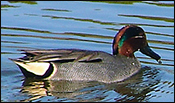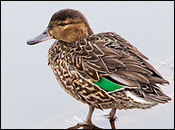Featuring: The Green-winged Teal
One of the smallest ducks of North America
Breeding Grounds
The teal spends its summer in most of Canada, along with states such as Alaska, Montana, North Dakota, Minnesota, Wisconsin, Michigan and Maine.
Migration Range
The Green-winged Teal migrates through the midline of the U.S. including Nebraska, Kansas, Missouri, Iowa, Illinois, Indian, southern parts of Michigan, Ohio, Kentucky, West Virginia and Pennsylvania. The duck has a year-round range in the western portion of the U.S. in Wyoming, Idaho, Utah and Colorado.
Wintering Grounds
The duck winters in all of the southern states in the U.S. along with Mexico and islands in the Caribbean.
Size & Shape
The duck displays a short neck and bill. As one of the smallest ducks in North America the Green-winged Teal only measures around 12.2 to 15.4 inches in length, with a wingspan around 20.5 to 23.2 inches and weighs 4.9 to 17.6 ounces.
Coloring
Male

The male has a chestnut colored head with a patch that goes from the eyes to the nape of the neck that is an iridescent green to purple. The chest is a brownish-pink color with small black spots while the back, sides and flanks are wavy grey with a white wing bar. The wing coverts are a brownish grey color with a hint of green. Both the bill and feet are grey.

Female
Less vibrantly colored than the males, females display a molted brown all over with a green wing patch and a dark brown line that extends from the bill through the eye. Like the male, the bill is also grey but the feet are olive grey to brownish grey. The female is slightly smaller than the male.
Habitat
Green-winged Teals prefer small, shallow permanent ponds, marshlands and marshy lakes near boreal forests that boast an abundance of emergent vegetation. They can also be found during the breeding season in the prairie pothole country or in areas with dense emergent vegetation.
Food
The dabbler duck eats the seeds of sedges, smartweeds, pondweeds, grasses, aquatic insects, mollusks, crustaceans and tadpoles. Young teal consume insects.
Behavior
The Teal is an early migrants and can be observed flying south in large flocks. The males depart before the females. Female Green-wined Teals work together to protect broods from predators such as skunks and crows.
Sound
Males are more vocal than females and are known for their high-pitched preep-preep call. Females give off a sharp high quack noise when flushed.
Conservation Status
Least Concern. In 1962, the Green-winged Teal population hit an all time low of 722,000 birds, since then their population has been steadily increasing and in 2009, the duck hit an all time high of 3.4 million individual ducks.
Interesting Facts
- Young Green-winged Teals have the fastest growth rate of all ducks.
- According to Cornell Lab, “The American and Eurasian forms of the Green-winged Teal were formerly considered different species. The Eurasian teal differ from the American by lacking the vertical white shoulder stripe and having a horizontal white stripe along the back instead. Eurasian teal show up casually each year along both the Pacific and Atlantic coasts.”
- The duck is among the fastest game bird capable of flying 60 MPH but more often is clocked at 50 MPH.


No comments:
Post a Comment